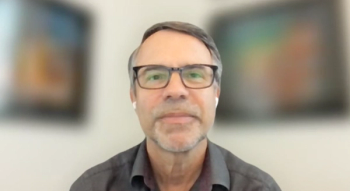
- June 2022
- Volume 28
- Issue 4
- Pages: SP208-SP209
Value-Based Care Will “Continue to Evolve” Even if OCM Expires

Four experts from The US Oncology Network partnered with The American Journal of Managed Care® to present a webinar, “Beyond the OCM: How Are Commercial Payers & Employers Delivering Value-Based Cancer Care?”
Absent a late change of heart from CMS, the Oncology Care Model (OCM) will end June 30, 2022, without a replacement—ending one of Medicare’s most ambitious efforts to shift the mindset and the results of cancer care delivery.1 However, the end of the model does not mean the lessons of balue-based care will cease. The challenge, many providers say, will be figuring out how to keep what worked in the OCM without the support of the model’s Monthly Enhanced Oncology Services (MEOS) payments, which helped practices afford navigation and nutrition services and social workers. This team-based approach is credited with bringing savings while keeping patients out of the hospital and improving their quality of life.2,3
With this transition looming, 4 experts from The US Oncology Network partnered with The American Journal of Managed Care® to present a webinar, “Beyond the OCM: How Are Commercial Payers & Employers Delivering Value-Based Cancer Care?” Lalan Wilfong, MD, vice president of payer relations and practice transformation at The US Oncology Network, moderated a discussion that featured:
• Rhonda Henschel, senior director of payer solutions,
• Ben Jones, vice president of government relations and public policy, McKesson Specialty Provider Organization, supporting The US Oncology Network, and
• Stuart Staggs, senior director of strategic programs.
Lessons From the OCM
Some larger practices have pushed back against reports saying the OCM was not a success—they say once practices learned to use the model correctly, they achieved savings for Medicare over predicted benchmarks. More importantly, the quality of patient care improved.3,4 To start the discussion, Wilfong asked how practices could retain the successes of the OCM and especially how commercial payers have responded to the movement toward value-based care, because they will be carrying the movement forward.
Staggs ran through the numbers for The US Oncology Network: the OCM has brought $240 million in savings for Medicare and going into 2020 the network had seen a 24% decrease in emergency department (ED) visits, a 37% decrease in hospitalizations, and an 11% increase in use of hospice care for more than 3 days. Just as important, he said, “We’ve established key things [such as] patient navigation, team-based care, better conversations around shared decision-making, and better access to enhanced services.” The OCM, he said, has created “a good foundation” for commercial plans to build value-based models in oncology, and for regulators to pursue the next wave of reform in Medicare.
Henschel said the OCM caused commercial payers to give more attention to managing the total cost of care, adding that 2 things stand out. “No. 1, we can drive the delivery of high-value care by aligning payer and provider incentives that ensure the right care is delivered at the right time and the right place of service,” she said. “And No. 2, the OCM highlights the different levers…such as care coordination or inpatient or ED reduction strategies and therapeutic interchanges that can reduce the cost of care by engaging with providers and aligning the different incentives.”
Wilfong agreed that creating payer and provider alignment to improve care—and cut costs—was essential. But increasingly, drugs form a large part of oncology care costs. Wilfong asked Jones to comment on how the OCM encouraged the use of biosimilars to drive down total care costs.
Providers, Jones said, often have limited control over drug costs; a novel therapy that is the best treatment available may not have a competitor. But when a biosimilar is available for a commonly used treatment, providers can help payers achieve savings—and Jones said policymakers are looking for incentives to encourage their use. “Patient care obviously comes first, but costs are in everyone’s minds,” he said. Among the federal agencies such as CMS, the US Department of Health & Human Services, or the Center for Medicare and Medicaid Innovation, “You can already see a lot of interest in the use of biosimilars—and a lot of hope that the uptake in biosimilars will really start to bend that cost curve in the total cost of care.”
Wilfong noted that at the start of the OCM in 2016, drug spend was about 40% of the total cost of care, and that share has increased to above 60% as the model nears its end—in part because practices have found ways to cut waste from the system elsewhere. But Wilfong said the OCM should not be judged only on whether it saved money. The model created incentives to treat patients more effectively and holistically, and to take proactive steps to keep them out of the hospital. In the past, he said, “At the end of the day, when you’re tired and busy and the nurse tells you that somebody called who’s having nausea—most of the time you’d be like, ‘Just go to the [ED],’ without really thinking through that,” he said. “And the [OCM] changed all that. All of a sudden, the incentives were there for you to make sure that you had access for those patients in your clinic, so that you could get them in and take care of them.”
Practices had to ensure staffing was available to help patients after hours, to provide access to records, and to inform individuals about more cost-effective therapies that might mean lower out-of-pocket costs. Wilfong asked Staggs what would happen if MEOS payments ended. He noted that patients—and even some in the healthcare system—may not realize that navigation and nutrition services are not reimbursed.
“That’s something that’s not just a concern of mine, but also the concern of our practices,” Staggs said. With the monthly payments as a foundation, practices invested in “patient-facing” resources such as navigation, nutrition, and social work—and they have seen the value. Having these additional staff available also allowed practices to make better use of nurses while capturing all the data needed to evaluate patients’ experience.
Stagg said practices are finding that “their patients have been making the best use of all these resources over the past 5 years. So, really, we’re trying to figure out a good bridge for them to maintain those resources and make them sustainable.”
Commercial Payers and Employers
How has the OCM changed the way other payers and employers approach value-based oncology care? Henschel said many payers have tried to adapt versions of the OCM to their infrastructure, but none are identical to the original. And “none or very few of them have any type of downside risk component for providers,” she said.
Value-based payment design is intensive, and the work involved has caused some to abandon the task. The lack of alignment across payers is tough for practices, and as a result the Community Oncology Alliance and the American Society of Clinical Oncology have worked to develop the Oncology Medical Home model, which would create standardization and “minimize the resource burden” for payers, Henschel said. Bundled payments and oncology case rates are becoming more common, she said, with some of this being handled by third-party administration.
What are the challenges for practices? Staggs concurred with Henschel’s comments about alignment, adding, “It’s really about stickiness,” meaning practices need to have a model they can count on using for several years instead of frequently changing course. Government models tend to last 5 years, whereas commercial models change more frequently, he said.
Wilfong said these burdens can distract from the goal of value-based care. “You can’t spend all of your administrative time focused solely on reporting requirements for various programs, because that takes away from your ability to take care of patients, which is our point,” he said. Sticking with a model long enough for it to work matters because it can take time to see the benefits. This was the case with the OCM. Early on, many practices struggled, but then there were 6 performance periods of sustained improvement. “And if we’d stopped too early, we wouldn’t have gotten there.”
The most important thing providers need from commercial payers, Jones said, is the “freedom to innovate.” The rise of vertical integration of payers and pharmacy benefit managers (PBMs), “particularly in the payer space where they’re bundling PBMs, payers, and specialty pharmacies—and even providers—is creating more of a tight rope around patient flow,” he said.
Payers may say they support value-based care, but imposing utilization management tools such as white bagging or steerage ultimately affects patient access to care. “There’s going to have to be some sort of change in mindset away from protecting revenue to really focusing on driving down total cost of care [while] protecting patient outcomes.”
“I completely agree,” Wilfong said. “If we’re taking responsibility as physicians and providers for managing this patient’s care and being responsible for the low-cost care, we need to have the freedom to be able to do that in collaboration with our payers.”
In addition, Henschel called for greater sharing and better transparency of data, so practices can quickly identify the “outliers,” or those who are practicing outside clinical guidelines or pathways. Finally, she discussed the challenge of attribution—which practice is responsible for the patient? Outdated accountable care organization arrangements may mean incentives are not directed to the right practice. “Payers are very unlikely to pay out more than 1 incentive on the same population,” she said. “So, they need to really…figure out how they can refine their attribution models to be rewarding the right providers for the care.”
“It’s All About the Drugs”
“Right now, in oncology, it’s all about the drugs,” Wilfong said. “There’s a ton of innovation happening, which is great. We’re seeing improved outcomes for patients, because of the innovation in drugs….But they’re really expensive.”
He asked Jones for an update on efforts in Washington, DC, to rein in drug prices. “This one is tricky, because candidly, almost everything is on the table right now,” Jones said. There are small proposals that address how quickly manufacturers can raise prices, and “very big, bold ones” that are less likely to pass but can frame debate. Even proposals that seem to have bipartisan support, such as inflationary caps or inflationary rebates, struggle to “make it to the finish line.”
“One thing that we do know is along [this] wide range of proposals, that Congress and the White House are going to keep exploring something until they can find something that sticks,” Jones said. “This is going to be a key issue leading up to the midterm elections, and it will very likely be an issue coming out of the elections.”
The focus on pricing Medicare Part B, which covers most oncology drugs, goes back to 2015; whether allowing Medicare to negotiate drug prices happens in Congress or through a Center for Medicare and Medicaid Innovation (CMMI) demonstration project, Jones expects it will be addressed in some way.
In the meantime, payers and employers are not waiting, and Henschel said it is tough for providers to make meaningful changes. Payers have deployed options such as step therapy, bagging policies, and shifts in site of care. PBMs may require that their own specialty pharmacy be used. Staggs also sees more emphasis on drug initiatives, including the conversion to biosimilars. Both he and Wilfong cited the need for clinical decision support tools to ensure patients receive therapy that is cost-effective—and not creating higher out-of-pocket costs with limited impact.
What’s Ahead
Jones said he wishes there were more clarity from CMMI on the future of an oncology model. “The short answer is, I think they’re going to do something. But the long answer is that it really depends on provider engagement.”
The evolution of the radiation oncology model shows how much comments from providers matter in shaping policy, he said, noting that the process is not over. CMMI’s mantra these days is to “focus on fewer models that touch more lives,” but that does not mean specialties such as oncology will be ignored.
Wilfong said he does worry about losing the momentum in the movement toward value-based care as the OCM ends. How will that hard-won buy-in from across the care team continue?
“I think it’s absolutely key to be open minded and approach these payer conversations with a collaborative mindset,” Henschel said. “None of these discussions [will] be easy,” she continued, adding that payers can be expected to approach things differently based on their own populations.
“Having open and candid conversations and trying to find alignment and what drives value—and making sure that we’re serving the interests of both the payer and the provider—I think is the only way that we’re going to be able to continue to move forward,” she said. “It’s just not a 1-size-fits-all solution across the board.”
Skaggs agreed. “It’s even more important now to continue to invest time and effort—and brainpower—into value-based care practices, because it’s not going to go away. It’s going to continue to evolve.
Wilfong noted that keeping the patient at the center is often discussed. “People say I’m naïve,” he said. “But I think unless we keep that as the core tenet of what we do, of really focusing on patient outcomes and what’s truly important for the patient, we’ll never get to a world we want to be in.”
References
1. Melillo G. With no replacement for OCM on horizon, oncology practices ask: what now? Am J Manag Care. 2021;27(9 Spec No.):SP390. doi:10.37765/ajmc.2021.88800
2. Colligan EM, Ewald E, Ruiz S, Spafford M, Cross-Barnet C, Parashuram S. Innovative oncology care models improve end-of-life quality reduce utilization and spending. Health Aff (Millwood). 2017;36(3):433-440. doi:10.1377/hlthaff.2016.1303
3. Kline RM, Blau S, Buescher NR, et al. Secret sauce-how diverse practices succeed in Centers for Medicare & Medicaid Services Oncology Care Model. JCO Oncol Pract. 2021;17(12):734-743. doi:10.1200/OP.21.00165
Articles in this issue
over 3 years ago
Pulling a Rabbit Out of the Hatover 3 years ago
Thyme Care: A Human Touch in Cancer Care, Guided by Technologyover 3 years ago
Adding Drug Costs to the Clinical Support EquationNewsletter
Stay ahead of policy, cost, and value—subscribe to AJMC for expert insights at the intersection of clinical care and health economics.









































